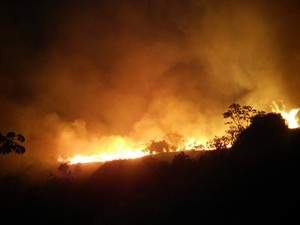
On Nov. 5 in the district of Bento Rodrigues in the town of Marianas in Minas Gerais state, Brazil, the Samarco mining operation's tailings dam failed, pouring 60 million cubic tons of water and iron ore waste into the town. This amounted to a gargantuan wave of mud, which is still flowing at this writing, continuing to devastate the surrounding area. Authorities are unable to enter the area, with only drones providing area pictures of the wide, spreading swath of green land affected. Two people are confirmed killed, and 28 people are still missing. It looks to be Brazil's biggest dam break ever.
Samarco is a joint venture of BHP Billiton Ltd. and Vale SA, two of the world’s biggest mining companies.
The dam's alarm system did not sound, leaving the residents without warning besides impromptu help provided by good Samaritans who helped some to evacuate. They only knew a dam had broken when some noticed a big cloud of dust in the sky 4 miles away in the direction of the dam. One man jumped on a flatbed and drove around yelling for people to flee; he was able to get out 60 people, including some elders. Meanwhile, others missed this improvised rescue operation. 200 homes were destroyed, with 800 left homeless.
According to the
Wall Street Journal, the residents of Bento Rodrigues reported that they had lived in fear of the dam put above their town, in their observation, without structural reinforcement. It appeared to be propped up with mounds of clay, and residents said that they were made nervous by seeing dam workers constantly patching parts of the dam. The residents had asked the company to improve safety--which met with no Vale actions to address residents' concerns.
According to
Places of Minas's online commentary (Lugares de Minas), this break is not singular but points to a bigger pattern of greed and land exploitation in the region. They ask, "Até quando Brasil? Cadê os órgãos responsáveis, que deveriam fiscalizar? Quantas comunidades, cidades, não estão no mesmo risco?" or, "How long will this go on, Brazil? Where are the responsible government bodies which should be regulating this activity? How many communities and cities are in the same danger?"
I actually have some personal experience with Vale mining company. In 2010, when I visited Minas Gerais, driving between Belo Horizonte and Ouro Preto, the beautiful green rolling hills were often gashed with orange, dramatically cut away. Curious, and suspicious of the roadside billboards describing how eco-friendly Vale was (which we suspected was so much green washing), we pulled off to the side of the road. We followed our noses off the ramp and up to a guard station that served as checkpoint into the Vale mined area. The station house was stocked with fully militarized guards, in paramilitary gear. We innocently asked if we could tour the facilities. This met with no smile cracked in the faces whose eyes were hidden behind shaded glasses. We hurriedly made a U-turn and left the way we had come, our curiosity about Vale's operations unquenched, but with a strong instruction in Vale's security system. Security, that is, for the operations--less so for nearby residents.
A tailings dam is built to shore up mine waste and water produced in the milling process. Sometimes in tailing ponds, other minerals are mixed with the mining waste in order to slow its dispersal into the environment. According to Scott Dunbar, department head of the Norman B. Keevil Institute of Mining Engineering at the University of British Columbia, tailings dams usually fail from excess of water in the tailings ponds. The people in the town were not warned.

The destruction of the town of Bento Rodrigues is all the more sad given the town's women's cooperative that collaborated to grow and harvest local fruits and chili peppers in order to make local delicacies that they sold in jars. This artisanal collective of poor rural women who harvested the land traditionally to create their own business--is now destroyed, primarily because the land, and all their homes and cooking facilities, were destroyed in the giant wave of mud.
Watch this video to see how the land looked prior to the Samargo mining company's dam fail. It is so peaceful and bucolic, it is truly heart breaking to think of these women entrepreneurs' efforts, and traditional lives, literally soiled and in ruins.
This is personally upsetting for me, knowing how people in country areas of Minas Gerais struggle to maintain a traditional lifestyle of tending the land--in the face of expanding mining operations.






